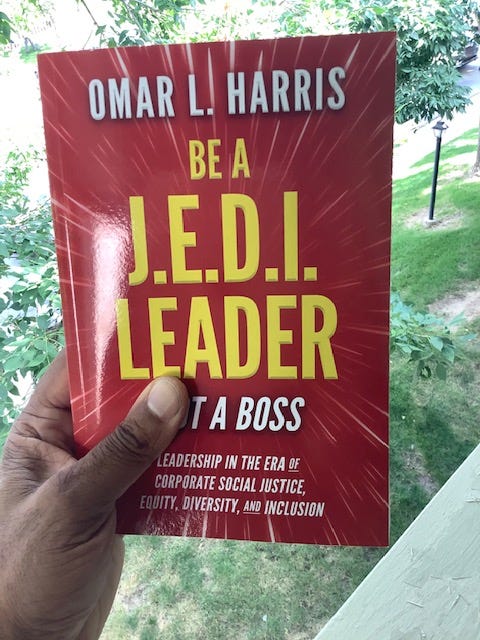Taking Flight Into The J.E.D.I Future — What’s Next For Justice, Equity, Diversity, Inclusion
In his recently released book “Be a J.E.D.I. Leader, Not a Boss: Leadership in the Era of Corporate Social Justice, Equity, Diversity, and Inclusion,” author Omar L. Harris explores the dark forces leading to separation, disunity, and disengagement in our rapidly changing world. These forces, he asserts, are currently fueling injustice and inequality — factors that keep a small group of leaders in power while others are subjugated.
The good news, says Harris, is that countervailing forces of resistance are emerging among leaders who understand the importance of businesses and other forms of stakeholder institutions that pursue a new cultural narrative where inequities are eradicated, diversity is championed, and inclusion is normalized.
Harris calls this movement (J.E.D.I.), an acronym for Justice, Equity, Diversity, and Inclusion. J.E.D.I., he says, is the foundational piece for bringing an empowered direction to employees, customers, communities, the environment, and shareholders worldwide.
In an interview with “Great Books, Great Minds”, Harris shares his vision and hope for a more just and inclusive world.
What is J.E.D.I. Leadership and what is its significance for our times?
J.E.D.I. Leaders are leaders who serve and support multi-stakeholders (employees, customers, communities, the environment, and shareholders), by focusing on the HOW of social justice, equity, diversity, and inclusion.
Are there other key elements of this model?
There are. For employees, this could mean leaders who work to end injustices tied to poor health and wellness practices in an organization. With respect to customers, this could mean leaders who are driven to eliminate inequities such as bias and racist lending practices to disenfranchised groups. And for communities, this could mean maximizing the diversity of suppliers the company works with by incorporating local veteran or minority suppliers into the mix.
With all of the emphasis these days on the environment, are any of these factors considered?
There are, for sure. This could mean leaders who enhance environmental inclusion by setting key performance indicators against environmental regeneration efforts and diligently tracking progress against these.
You assert in your book that leaders can no longer merely focus on their own ego, ambition, and success at the expense of employees, customers, communities, and the environment. Can you describe the significance of this?
My message here is that we must tackle the inherent and systematic toxic business practices that have for too long disenfranchised employees, disregarded customers, disrupted communities, and destroyed the environment, all in the spirit of greater corporate profits and investor greed.
So what is the predominant message you are seeking to deliver relative to corporate social justice, equity, diversion, and inclusion?
That I believe it is crucial for business leaders at all levels to step up and meet this moment in time, one where compassionate capitalism is gaining steam and embrace the hard work of eradicating injustices, eliminating inequities, expanding diversity, and enhancing inclusion. The focus should start with employees before moving on to other key stakeholders - customers, communities, and the environment. The aim here is to create a better world built on the back of better businesses.
Tell us about your own leadership journey
I’ve observed racial inequities over the course of my career first as the only black person in marketing for a 30,000 person corporation, then as the only black General Manager outside of the African nations, and ultimately the only black General Manager in the world for my last employer.
What did you discover from these leadership experiences?
I learned that it was extremely difficult to lead in the same way (power and ego-based) as my male contemporaries. As a result, I began adopting principles of positive psychology, servant leadership, and compassionate capitalism to elevate my leadership style. I discovered that I had to be so much better than my white counterparts to get the same level of recognition.
How did all of this inform the message of your book?
From my success in leading with this anti-conformist approach, I knew that more leaders of all stripes could succeed without having to emulate the toxic ego-driven bosses before them. So, I committed myself to researching and learning as much as I could about this way of thinking. This coupled with my own experiences in leading organizations around the world provided a straightforward blueprint for succeeding with such a novel approach.
What are your thoughts about the various diversity, equity, and inclusion initiatives currently taking place in organizations worldwide?
In my view, DEI leaders are suffering from burnout at an alarming rate. Sadly, many are languishing and lacking the flow and energy to keep pushing the boulders up the hill.
So what can we do to address this?
We need milestone markers that demonstrate that we are truly marching forward. I believe we must celebrate every success on the journey, regardless of how small the step is on our desired destination. The aim should be a world where everyone can fully participate regardless of who they are, how they identify, or where they come from. With this, it is important to break the effort down into manageable chunks so that we can drive at these milestones with all the focus we can muster.
Are there specific practices you advocate for as a part of this?
Leveraging the power of storytelling is a powerful way of emotionally connecting more people to this important work. It offers the opportunity to demonstrate the difference that changing harmful policies makes on real people's experiences in a way that is undeniable.
We hear so much talk these days about employee engagement. How does this differ from efforts to foster inclusion?
The call to action for the past decade or so has been about enhancing career-based employee engagement in order to increase productivity and hopefully, results. But most corporations are truly only focused on ensuring that their definition of high performers or "talents" are fully engaged - aka the "A players" theory.
What has always been missing from these analyses was the aspect of inclusion. Problems occur when the focus is on maintaining an archaic talent management system focused on these top talents while still saying that they are all about inclusion?
How can companies then pursue a different narrative?
To enhance inclusion and by proxy, true engagement (inclusion is truly valuing everyone and engagement is truly involving everyone), companies need to go back to the drawing board on their key processes, identify the problematic issues and work to innovate New Operating Procedures for resolving these issues. At this point, they can begin to initiate corrective and preventative actions (CAPAs). In the end, there is no employee engagement without inclusion regardless of what a company’s demographics might look like today.
You have said that there is a fundamental mismatch between what industries have the most job openings now and how many unemployed people used to work in those industries pre-pandemic. Can you share a few thoughts on this?
Yes, I've been talking a lot about this lately. Businesses are not only competing against one another for employees in the digital age, they are also competing against new digital income drivers like gig work, professional blogging, online entrepreneurship, social media payouts, affiliate marketing, cryptocurrency investment, day-trading, and a myriad of other opportunities. This is allowing talented individuals to make a living without dealing with the injustices and inequities of working in a corporation nowadays.
Employees have never had more choice in where and how they want to make a living. For them to choose a corporation goes beyond just "needing a job" - the job must demonstrate how it values them, how it will develop them, and how it will help them achieve their goals.
What can companies be doing then to address this?
It requires a reinvention of leadership, pure and simple. But first, there must be an acknowledgment of the brutal fact that business as usual is dead.
In some respects, this war is already lost. Leadership 2.0 has failed modern employees and workforces. Now we must rebuild in the aftermath and aspire to be the leaders and build the company cultures employees won't want to leave.
How can J.E.D.I. Leadership help here?
Work is evolving away from the standard top-down hierarchy and toward a more lean, agile, collaborative, and decentralized organizational model. As the modern leadership gurus from Stephen Covey to Simon Sinek have been advocating for years now, modern models require modernization of leadership.
By tuning into employee needs, managers and organizational leaders will become far more aware of the internal injustices, inequities, uniformities, and exclusions their people face in trying to do their best work. Attacking these issues requires leaning into the principles of justice, equity, diversity, and inclusion and influencing the transformation of internal policies, frameworks, procedures, and systems into those that enhance J.E.D.I. for everyone.
J.E.D.I. is not the work of a few — it requires a systemic top-down commitment to positive actions to eradicate toxic factors in favor of a culture where justice is prioritized, equity is the standard, diversity is truly valued and leveraged, and inclusion is commonplace.
What emerging themes should be front and center on a J.E.D.I Leader’s radar screen over the next 12-18 months?
J.E.D.I. work is fundamentally about taking people, divisions, functions, and whole companies through the 6 A's of J.E.D.I. action (awareness, acceptance, appreciation, alignment, activation, and advocacy). These can be applied anywhere that injustice, inequity, whitewashing, and exclusion exist.
A good starting point is to look at the 5 business sins of inequity - privileged hiring, sink or swim onboarding, talent whitewashing, corrupted compensation, and targeted termination policies and procedures. Then the work of identifying the problems and issues related to inequities within each can begin.
From there corrective and preventative actions can be created along with new and innovative operating procedures that no longer possess these inequities. Once all of this occurs, the effective communication and training of new policies, including their enforcement, implementation, and course correction can be initiated.
What is your greatest hope in terms of what readers walk away with from your book?
I hope readers are inspired and see that businesses and corporations have the unique opportunity to heal the nation and the world more so than any other societal structure today. This occurs when there is a shared organizational purpose that's bigger than profits and that embraces the J.E.D.I. principles covered in the book. In the end, the goal is to ensure that employees, customers, communities, the environment, and shareholders all thrive. This is how we make a better world!






